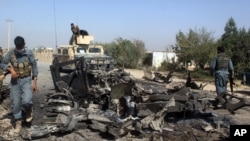The United States has launched about a “half-dozen” airstrikes across Afghanistan in the past 30 days, part of an effort to support Afghan security forces attempting to hold the Taliban at bay.
A U.S. defense official told VOA on Thursday that the strikes, most of them carried by U.S. drones, targeted “captured military equipment that the Taliban [were] able to seize from the ANDSF [Afghan National Defense and Security Forces]."
"There were enemy forces, enemy personnel targeted" alongside the captured equipment, the official added, speaking on the condition of anonymity because of the sensitive nature of the information.
For days, Afghan civilians have claimed to have seen U.S. military aircraft, with some reports suggesting the U.S. was behind airstrikes in Kandahar, where Taliban forces had been advancing.
But until now, U.S. officials had refused to say whether they supported Afghan ground forces with any of the assets sent to the region — including long-range bombers and the USS Eisenhower Carrier Strike Group — to help protect U.S. forces as they withdraw from Afghanistan.
“There’s no switch that was turned on. There’s no change in policy,” the official told VOA, saying the recent airstrikes were part of Washington’s over-the-horizon strategy.
Earlier Thursday, Pentagon press secretary John Kirby told reporters the U.S. had carried out airstrikes to support Afghan forces over the “last several days,” though he declined to share specifics.
Pentagon officials said earlier this month that the commander of U.S. forces in the region, Central Command’s General Kenneth “Frank” McKenzie, would retain the authority to call for airstrikes in support of Afghan forces until the U.S. withdrawal from Afghanistan was complete.
Military planners have said they expect the pullout to be done by August 31, in line with the direction from U.S. President joe Biden.
Word of the handful of U.S. airstrikes in Afghanistan came a day after America’s most senior military officer admitted that the Taliban had gained “strategic momentum,” with their forces now controlling about half of Afghanistan’s more than 400 district centers.
General Mark Milley, chairman of the Joint Chiefs of Staff, also said Taliban forces were putting pressure on 17 of Afghanistan’s 34 provincial capitals.
"What they're trying to do is isolate the major population centers," Milley told reporters Wednesday. "They're trying to do the same thing to Kabul, and roughly speaking … a significant amount of territory has been seized."
Some U.S. lawmakers have expressed concerns about what will befall the Afghan government without a U.S. military presence on the ground, at times pointing to reports that U.S. intelligence agencies have predicted the government will fall in six months.
But in an interview with National Public Radio on Thursday, Central Intelligence Agency Director Bill Burns admitted that while “the trend lines are certainly troubling,” the Afghan government is far from helpless.
“The Afghan government retains significant military capabilities,” Burns said. “The big question, it seems to me and to all of my colleagues at CIA and across the intelligence community, is whether or not those capabilities can be exercised with the kind of political willpower and unity of leadership that's absolutely essential to resist the Taliban.”
Ayaz Gul contributed to this report.






